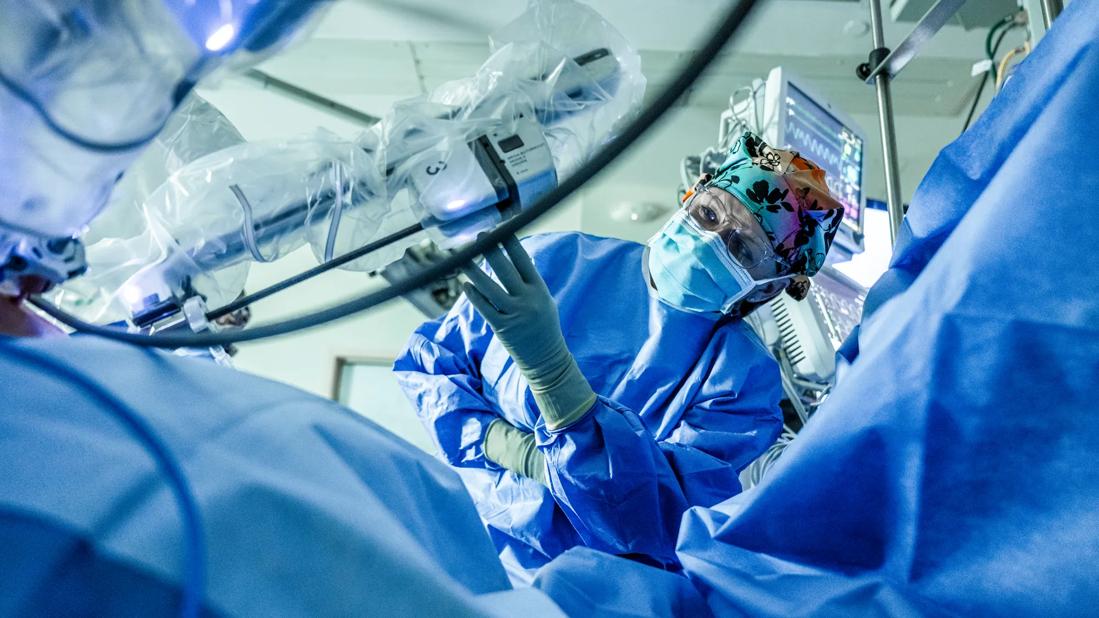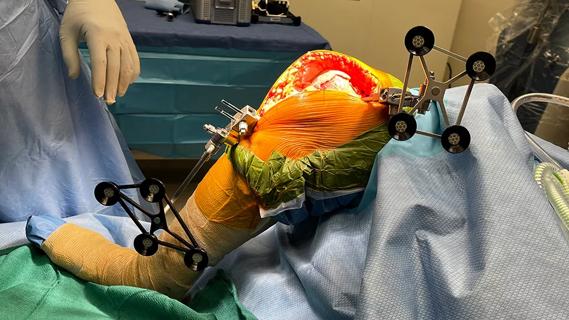As robotics in the OR grows, so does the role of nurses

Approximately 40% of men with newly diagnosed prostate cancer opt for a radical prostatectomy, more than 90% of which are performed with robotic assistance.
Advertisement
Cleveland Clinic is a non-profit academic medical center. Advertising on our site helps support our mission. We do not endorse non-Cleveland Clinic products or services. Policy
“Robotic-assisted surgeries provide better outcomes, better preservation of structures and almost no post-operative stays,” says Alex Vasilevskiy, BSN, RN, Assistant Nurse Manager of Urology in Surgical Operations at Cleveland Clinic. “With open prostrate surgery, patients would stay in the hospital for several days so we could monitor them. Now they are sent home the same day with a small incision and minimal blood loss.”
Prostatectomies are just one procedure for which Cleveland Clinic’s Glickman Urological Institute utilizes a single-port (SP) robotic platform. Others include bladder diverticulectomies, partial nephrectomies, radical cystectomies and intracorporeal urinary diversions, and kidney transplantation. In 2024, the Glickman Urological Institute accomplished an important milestone, surpassing 1,000 SP robotic urological cases. In addition, robotic-assisted surgeries are performed in ear, nose and throat procedures, plastic surgery, orthopedics, neurology and other specialties.
Nurses play a crucial role in robotic-assisted surgeries, coordinating equipment usage, ensuring a sterile environment, monitoring and assessing patients, providing surgical assistance and more.
Vasilevskiy says that SP robotic surgery represents the biggest transformation he has seen in his career in perioperative nursing. The platform features a single, narrow robotic arm that can simultaneously accommodate three double-jointed robotic instruments and a flexible, high-definition camera. All the instruments can be introduced through a single 3-cm incision.
Advertisement
“One of the great features of the robotic system is the visualization,” says Carol Lung-Paskoff, BSN, RN, Nurse Manager of Urology and Gynecology in Surgical Operations. “In prostatectomies, surgeons can see and preserve nerves that control bladder and erectile function, which is very important for our patients. For patients with kidney tumors, surgeons can clearly see all of the anatomy and perform a partial nephrectomy rather than removing the entire kidney.”
Kidney transplantation is one of the procedures most impacted by robotics. Cleveland Clinic performed the first successful robotic single-port kidney transplant in 2019. Last year, surgeons at the healthcare system orchestrated the first nearly simultaneous kidney transplant procedure for a donor and recipient using one SP robot. They also performed a robotic-assisted pancreas transplant in January 2024.
Cleveland Clinic health system transplanted a total of 1,357 organs in 2024, 60 of which were done via robotic-assisted surgery.
Bryant Gaskell, BSN, RN, CNOR, is the third nurse to serve as Surgical Robotic Coordinator at Cleveland Clinic, a position created several years ago in response to growth of the field. (Vasilevskiy held the position prior to Gaskell.)
“The perioperative nursing setting is oriented heavily toward usage of a multitude of surgical devices, including the growing trend of robotics in surgery,” Gaskell explains. “Surgical robotics offers a unique set of challenges that makes each week exciting – challenges such as point-of-use troubleshooting, scheduling processes and strategies to make sure the robots aren’t over booked and are in the correct ORs, robot component configuration per type of surgery and footprint of the OR, as well as teaching and training new and current caregivers on the various robots we employ.”
Advertisement
Education and training are critical to ensure clinical nurses are prepared for the workload. In 2024, 2,368 procedures were performed at Cleveland Clinic's Main Campus using various robotic surgical systems.
Training occurs during orientation conducted by service lines. Within urology and gynecology, nearly all perioperative nurses receive one-on-one instruction from Gaskell on robotic systems.
“We focus in on the details – draping the robot, sliding sheaths on the robotic instruments, making sure the tip is on the scissor correctly,” Gaskell says. “Each robot is different so it can be challenging.”
Next, nurses are paired with a preceptor and receive additional hands-on training. They begin in the scrub role for six weeks before circulating. Nurses also spend time during orientation in other service lines.
“Robotics training takes a lot of time,” Lung-Paskoff says. “We start new nurses out slowly on basic cases, then expand into more complex cases, such as kidney transplants.”
Multidisciplinary teamwork helps ensure successful robotic surgical procedures. Gaskell and Lung-Paskoff are members of Cleveland Clinic’s Robotics Steering Committee, which meets quarterly. The committee devotes part of each meeting to discussing the latest trends in robotics, which the nurses share with their colleagues.
“The precision and minimally invasive nature of robotic surgery means better outcomes and faster recoveries for patients. Knowing that our team plays a role in that is incredibly rewarding,” says Lung-Paskoff. “Each day I come to work motivated by the collaboration and expertise of my team, the ever-evolving technology and the opportunity to make a tangible difference in patients’ lives.”
Advertisement
Advertisement

Study finds that fracture and infection are rare

Cleveland Clinic orthopaedic surgeons share their best tips, most challenging cases and biggest misperceptions

How hospitals can weave ethics into daily nursing practice to strengthen patient-centered care

Guiding nurses amid a constantly evolving healthcare landscape

Ideation session generates solutions to medication administration errors

Caregivers spearhead changes that improve patient care, shape hospital culture

Building a culture that supports, engages and empowers nursing staff

Nurses harness cutting-edge technology as a bridge to healing